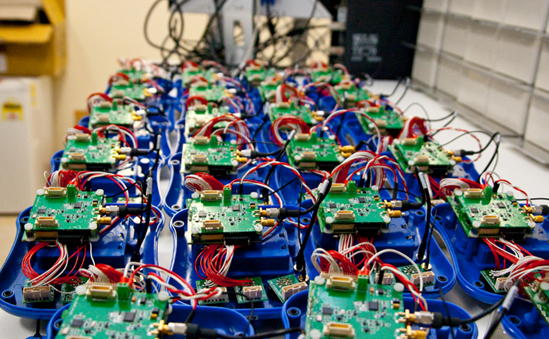 Springbrook Rescue
Springbrook Rescue
 Springbrook Rescue
Springbrook Rescue
| Home | The Vision | Springbrook — A Natural Wonder | The Springbrook Rescue Project | Support the Project | About ARCS |
|
The Science | |||||||
| |||||||
|
Science Projects
| |||||||
|
Wireless Sensor Network (Project SRC2) The Wireless Sensor Network, established in 2008, on the Springbrook rainforest restoration property, Pallida (2824 Springbrook Road in the Boy-ull Creek Catchment), is a collaborative project involving the Department of Environment and Heritage Protection (EHP), the CSIRO and ARCS. The aim of the project is to provide critical real-time data on the environmental drivers of habitat quality and ecosystem dynamics during rainforest recovery after clearing. Importantly, the project will also potentially provide data on climate change in this World Heritage area. The Springbrook Wireless Sensor Network Project won the Queenlsand iAwards for Research and Development in 2012. The award was presented by the Hon Ros Bates, Minister for Science, Information Technology, Innovation and the Arts. |
|||||||
 Dr Gordon Guymer (Queensland Herbarium)(Right) and Darren Moore (Head, Autonomous Systems Laboratory, CSIRO)(Left) receive the iAward from Hon. Ros Bates at the gala ceremony in 2012. |
|||||||
The monitoring system includes a state-of-the art, continuously operating wireless sensor network with 175 nodes and 700 individual sensors providing long-term, catchment-wide micro-meteorological and soil hydrological data (including changes to the cloud base and the degree of cloud immersion). The project allows correlation of climatic, edaphic and physiographic data with plant recruitment, mortality and productivity data at ecologically relevant spatial and temporal scales ranging from microsites to meso-sized catchments over the long term. The design was informed by our ecological conceptual model which underpins consideration of all restoration interventions. The 175 nodes located across the study site each consist of a mini-computer with several attached sensors. The nodes ‘talk’ to each other such that the data collected from the sensors ‘hop’ using wireless technology from node to node and eventually to a central hub via the most energy-efficient routes. From the hub, the data are transferred via the internet to a ‘super’ database at the CSIRO in Brisbane. The basic ecological design involved placement of nodes with varying numbers of sensors per node at 50-metre intervals along each 10-metre contour ensuring replicated sampling of differences in aspect and quality and quantity of vegetation cover. There are at least five or more nodes at each contour interval from 790m to 910m (See Chart below.). Forty per cent of nodes are in cleared areas, 30% at forest edges and 30% are within regenerating forests. ARCS recommended the type, number and placement of sensors in the system to most usefully and feasibly guide and monitor restoration. Costs of different sensors constrained the numbers that could finally be deployed. Engineering design and data storage are the responsibility of the CSIRO. All nodes measure basic parameters of air temperature, relative humidity, leaf wetness and soil moisture. These are complemented by additional sensors that measure rainfall, solar radiation, wind speed and direction, barometric pressure, cloud immersion, carbon dioxide levels and soil water potential. With an average of five variables recorded at each of the 175 sensor nodes every five minutes, 252,000 observations are recorded and transmitted to the central node (sink) each day, or over 90 million each year. This represents challenges for sampling, storage and analysis that are being overcome by CSIRO. Thus, as all wireless sensor networks are constrained by energy, communication bandwidth, transmission range, and storage capacity, the Springbrook deployment provides an excellent research test bed to improve the design of networks in order for the transformational potential of this environmental monitoring technology to be fully realized. A separate battery-powered, Wireless Multimedia Sensor Network (WMSN) monitors animal movements and sounds. This audio and video recording program will be particularly valuable in monitoring the recovery of faunal habitat. A brochure on the Wireless Sensor Network can be downloaded here. Links CSIRO http://research.ict.csiro.au/research/labs/autonomous-systems/sensor-networks/sensor-networks 
Sensors currently in place measure —
Additional sensors will include sap-flow sensors and dendrometers to automatically monitor and correlate plant growth and water use. Springbrook is an ideal testing platform for this state-of-the-art technology because of the sharp environmental gradients (e.g. 200–1050 m altitude, 1800 to >3500 mm annual rainfall, leached skeletal soils to deep, nutrient rich basalt-derived soils) within a relatively small area of complex terrain. Results will start to be published in peer-reviewed journals when sufficient, statistically robust data are accumulated. |
|||||||
  The 175-node WSN Network in the Boy-ull Creek Catchment, Springbrook  The first 9 anenometers ready to be installed in April 2008. Photo: Aila Keto  Open Datacall Flecks during preparation for node deployment in February 2010. Photo: © N. Kottege (CSIRO)  Setting up one of the nodes in regrowth forest. Photos: Keith Scott  Testing data transmission from one of the forest interior nodes with the help of a Yagi antenna  Aila Keto (ARCS) and Garry Foley (a CSIRO software engineer) discussing potential triggers for efficient ‘event’ sampling at one of the first nodes to be established (April 2008). Photo: Keith Scott
|